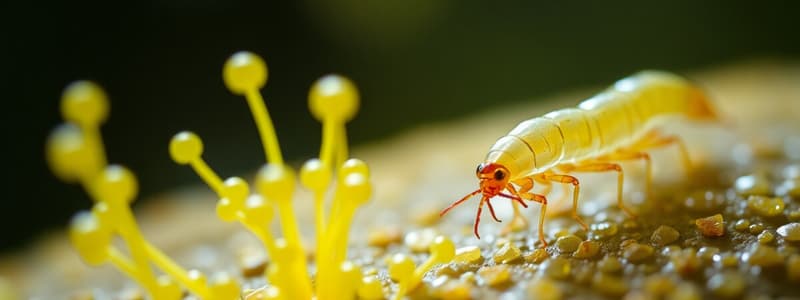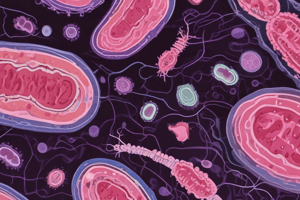Podcast
Questions and Answers
What is the primary function of a phase contrast microscope?
What is the primary function of a phase contrast microscope?
- To provide three-dimensional images of samples
- To absorb light from specific cellular components
- To stain samples for better visibility
- To view live samples without staining (correct)
Which microscopy technique utilizes polarized light for enhancing contrast?
Which microscopy technique utilizes polarized light for enhancing contrast?
- Light field microscope
- Confocal microscope
- Fluorescence microscopy
- Differential Interference Contrast microscopy (correct)
What is a limitation of using a light field microscope?
What is a limitation of using a light field microscope?
- It can only be used with opaque samples.
- It provides no contrast enhancement.
- It requires samples to be stained. (correct)
- It can only observe live cells.
What is a common use of Differential Interference Contrast microscopy?
What is a common use of Differential Interference Contrast microscopy?
Which of the following statements is true regarding the contrast in the phase contrast microscope?
Which of the following statements is true regarding the contrast in the phase contrast microscope?
What potential issue does Differential Interference Contrast microscopy present in its imaging?
What potential issue does Differential Interference Contrast microscopy present in its imaging?
What is the main benefit of using a confocal microscope?
What is the main benefit of using a confocal microscope?
How does a light field microscope primarily enhance contrast?
How does a light field microscope primarily enhance contrast?
What is the maximum magnification power of a conventional light microscope?
What is the maximum magnification power of a conventional light microscope?
Which microscope type has the highest resolving power?
Which microscope type has the highest resolving power?
What is the resolving power of a conventional light microscope?
What is the resolving power of a conventional light microscope?
Which component of the conventional light microscope is not part of its optical system?
Which component of the conventional light microscope is not part of its optical system?
What is the numerical aperture (NA) related to in the context of microscopy?
What is the numerical aperture (NA) related to in the context of microscopy?
Which of the following statements about electron microscopy is correct?
Which of the following statements about electron microscopy is correct?
Which part of the conventional light microscope is responsible for focusing light onto the sample?
Which part of the conventional light microscope is responsible for focusing light onto the sample?
What physical property does a light microscope primarily rely on to visualize specimens?
What physical property does a light microscope primarily rely on to visualize specimens?
What is the main principle behind multiphoton microscopy?
What is the main principle behind multiphoton microscopy?
What limits the resolution in biological samples when using electron microscopy?
What limits the resolution in biological samples when using electron microscopy?
In transmission electron microscopy (TEM), what is the purpose of the cathode?
In transmission electron microscopy (TEM), what is the purpose of the cathode?
What is the typical thickness of samples required for electron microscopy?
What is the typical thickness of samples required for electron microscopy?
Which heavy metal salt is NOT typically used to achieve contrast in TEM?
Which heavy metal salt is NOT typically used to achieve contrast in TEM?
What is the role of the electromagnetic coils in a TEM setup?
What is the role of the electromagnetic coils in a TEM setup?
What factor limits the aperture angle in electron microscopy's objective lens?
What factor limits the aperture angle in electron microscopy's objective lens?
Flashcards
Numerical Aperture (NA)
Numerical Aperture (NA)
The maximum angle of light that can enter the lens after passing through immersion oil.
Resolution Limit
Resolution Limit
The smallest distance between two points that can be distinguished as separate.
Light Field Microscope
Light Field Microscope
A type of microscope that uses visible light to illuminate the sample and produces images based on the light's absorption by the sample.
Phase Contrast Microscopy
Phase Contrast Microscopy
Signup and view all the flashcards
Differential Interference Contrast (DIC) Microscopy
Differential Interference Contrast (DIC) Microscopy
Signup and view all the flashcards
Fluorescence Microscope
Fluorescence Microscope
Signup and view all the flashcards
Confocal Microscope
Confocal Microscope
Signup and view all the flashcards
Multiphoton Microscope
Multiphoton Microscope
Signup and view all the flashcards
Resolving Power
Resolving Power
Signup and view all the flashcards
Magnification
Magnification
Signup and view all the flashcards
Optical Microscopy
Optical Microscopy
Signup and view all the flashcards
Electron Microscopy
Electron Microscopy
Signup and view all the flashcards
Transmission Electron Microscopy (TEM)
Transmission Electron Microscopy (TEM)
Signup and view all the flashcards
Conventional Optical Microscope
Conventional Optical Microscope
Signup and view all the flashcards
Super-Resolution Microscopy
Super-Resolution Microscopy
Signup and view all the flashcards
Resolution
Resolution
Signup and view all the flashcards
Scanning Electron Microscopy (SEM)
Scanning Electron Microscopy (SEM)
Signup and view all the flashcards
Heavy Metals
Heavy Metals
Signup and view all the flashcards
Embedding
Embedding
Signup and view all the flashcards
Study Notes
E. coli Growth Conditions
- Under optimal conditions, E. coli divides every 20 minutes.
- Rapid growth media contains glucose, salts, and various organic compounds like amino acids, vitamins, and nucleic acid precursors.
- Slow growth media contains salts, a nitrogen source (like ammonia), and a carbon and energy source (like glucose).
Caenorhabditis elegans
- Multicellular organism with an elongated tube shape, thinning at the ends.
- Consists of approximately 959 somatic cells and 1000-2000 germ cells.
- Easily reproduced and genetically manipulated in the lab.
- Covered by a fine outer cuticle.
- Organised into simple organs and systems, including a digestive system (with a stoma/mouth, pharynx, and intestine), sexual organs (gonads), and a rudimentary nervous system.
C. elegans Genome
- First multicellular organism to have its genome sequenced (1998).
- Approximately 100 million base pairs long.
- Consists of six chromosomes and one mitochondrial genome.
- Estimated 19,000 protein-coding genes.
- 36% of C. elegans genes have human homologues.
Danio rerio (Zebrafish)
- Small, active fish commonly found in aquariums.
- Natural habitat in calm, sometimes stagnant waters of central Asia, particularly the Ganges region of India.
- Adults typically between 3-5 cm long and 1 cm wide, depending on environment.
- Elongated shape with a dorsal fin and 5-9 bluish bands along the sides; males are golden, females are silver.
- Ventral area is whitish and pink. This banding pattern earns it the name "zebrafish."
Organoid Cultures
- A diverse array of organoids, encompassing intestinal, lung, gastric, and other tissues.
- Includes both 2D and 3D cultures and animal models.
Microscopy techniques
- Light field microscopy: Light directly passes through the cell. Distinguishing cell parts depends on contrast from visible light absorption. Fixation (stabilizing tissue) and staining are used for better contrast.
Microscopy techniques
- Phase contrast microscopy: Allows viewing live samples without staining. By manipulating light, it increases contrast in samples, revealing structures not visible through normal microscopy.
Microscopy techniques
- Differential Interference Contrast (DIC): A contrast-enhancing technique that converts phase delays into intensity changes, producing a pseudo-3D image of transparent samples. Useful for imaging live, unstained biological samples.
Microscopy techniques
- Fluorescence Microscopy: Based on fluorescent substances that absorb and emit light at specific wavelengths. Used to label structures and observe intracellular distributions of molecules in fixed and live cells.
- Widefield Fluorescence Microscopy: Light passes through an excitation filter, a dichroic mirror, and a barrier filter to isolate and visualize fluorescently stained cellular components.
Microscopy techniques
- Widefield fluorescence
- Confocal Microscopy: Allows detailed microscopy by analyzing fluorescence from a single plane in thicker samples, eliminating out-of-focus signals for sharper images. Used for multicolor immunofluorescence analysis and creating three-dimensional (3D) images.
Microscopy techniques
- Multiphoton Microscopy: Requires two or more photons for fluorescent dye excitation. This results in fluorescence localized in the focal plane of laser light, limiting out-of-focus illumination. Ideal for deep tissue imaging.
Microscopy techniques
- Electron Microscopy: Uses a beam of accelerated electrons to obtain higher resolution images of cellular structures than is possible with light microscopy. Transmission electron microscopy (TEM) and scanning electron microscopy (SEM) are different types.
Microscopy techniques
- Transmission Electron Microscopy (TEM): Uses a beam of electrons to visualize a very thin sample. Differential absorption of heavy metal salts creates contrast between areas.
Microscopy techniques
- Scanning Electron Microscopy (SEM): Used to image surfaces in three dimensions. The sample is coated with a heavy metal, and electrons from the sample surface are collected and projected onto a screen to create a three-dimensional image.
Specimen preparation
- Histological Processing methods include fixation for stabilizing tissues, tissue embedding for structural support, sectioning using a microtome or ultramicrotome for thin slices, and staining to highlight structures.
Specimen preparation
- Fixation: Stops cell degradation processes. Physical: cryofixing using sub-freezing temperatures to decrease enzymatic activity and immobilize structures. Chemical: using chemicals like formaldehyde to stabilize cellular macromolecules.
Specimen preparation
- Tissue Embedding: Replacing water in tissues with solid media (paraffin for light microscopy or resins for electron microscopy) to give structural support and facilitate slicing.
Specimen preparation
- Sectioning: Creating thin slices of embedded tissues using a microtome or ultramicrotome.
Specimen preparation
- Staining: Highlighting specific structures and components using dyes with varying affinities for cell components.
Flow Cytometry
- Technique for analyzing number, size, and complexity of cells in a suspension by passing cells through a laser beam, detecting light scatter (forward and side) and fluorescent signals.
Subcellular Separation
- Methods include physical methods (osmotic shock, ultrasound, mechanical grinding) and enzymatic methods (enzymes like lysozyme) to break down cells, separate subcellular components, and obtain better-defined specimens for downstream investigations.
Differential Centrifugation-
- Separates components in a mixture based on size and density using centrifugation at high speeds. Larger and denser components settle faster. Requires an ultracentrifuge.
Density Gradient Centrifugation
- Separates components in a mixture based on density using a gradient of a dense medium (like sucrose or cesium chloride). Components separate into bands based on their density.
Cell Cultures
- Isolating and maintaining cells in a laboratory environment for research.
- Allows manipulation and study of cells in a controlled setting.
- Differentiates between normal and tumour cell cultures.
Viruses
- Use cells as a host to replicate.
- Growth of viruses depends on the host cell type.
- Can facilitate studies of molecular mechanisms, RNA potential, and oncogene discovery.
Immunochemical Techniques
- Identifying specific proteins in tissue sections using antibodies tagged for visual detection. (direct & indirect)
Immunochemical Techniques
- Direct method uses a labeled antibody that binds directly to the target protein.
- Indirect method uses an unlabeled primary antibody followed by a labeled secondary antibody that recognizes the primary antibody.
Cell cultures
- Immortal cells: derived from tumors, growing indefinitely in culture. Examples: HeLa cells.
- Embryonic stem cells: derived from early embryos, differentiating into all adult cell types.
Studying That Suits You
Use AI to generate personalized quizzes and flashcards to suit your learning preferences.
Related Documents
Description
This quiz explores the growth conditions and biological characteristics of E. coli and Caenorhabditis elegans. Understand the media used for optimal and slow growth in E. coli and delve into the unique features of C. elegans, including its anatomy and genome. Perfect for biology students and enthusiasts!




